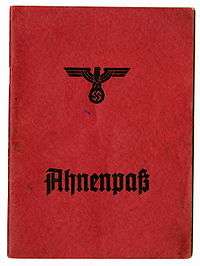Ahnenpass


The Ahnenpaß (literally, "ancestor passport") documented the Aryan lineage of citizens of Nazi Germany. It was one of the forms of the Aryan certificate (Ariernachweis).
The term Aryan in this context was used in a sense widely accepted in scientific racism of the time, which assumed a Caucasian race which was sub-divided into Semitic, Hamitic and Aryan (Japhetic) subraces, the latter corresponding to the Indo-European language family; the Nazi ideology limited the category Aryan to certain subgroups, while excluding Slavs as non-Aryan. Nevertheless, the de facto primary objective was to create extensive profiling based on racial data.
The investigation for lineage was not obligatory as it was a major undertaking to research the original documents for birth and marriage. Many Nazi followers had already begun to research their lineage even before law required it (soon after the NSDAP took power on 30 January 1933).
One important law which was issued on 7 April 1933 (after the Nazi assumption of power) was called the Law for the Restoration of the Professional Civil Service, and it required all public servants to be of Aryan descent. The law, however, did not define the term "Aryan" and a subsequent regulation was issued on 11 April as the first legal attempt by the Third Reich to define who was, and who was not, a Jew. Germans aspiring for the document had to prove they didn't descend either from Jews or Slavs.[1] The Ahnenpass was given out to citizens of other countries, under the condition that they were of "German blood"[2][3] and it itself stated that "wherever they might live in the world" Aryans could be members from nations like e.g. the English, Swedish, French, Czech, Polish or Italian,[3][4] German minorities in these countries were called Volksdeutsche. The Reich Legislative Gazette, i.e. the official Reichsgesetzblatt, used the terminology "German or racially related blood".[5]
The implementing decree followed the pre-Nazi trend found in the Aryan Paragraph[6] and read in pertinent part that:
„Als nicht arisch gilt, wer von nicht arischen, insbesondere jüdischen Eltern oder Großeltern abstammt. Es genügt, wenn ein Elternteil oder ein Großelternteil nicht arisch ist. Dies ist insbesondere dann anzunehmen, wenn ein Elternteil oder ein Großelternteil der jüdischen Religion angehört hat.“
Those are not Aryans who descend from non-Aryan, especially Jewish, parents or grandparents. It is sufficient (grounds for exclusion) for one parent or grandparent to be non-Aryan. This is particularly assumable if a parent or grandparent adhered to the Jewish religion.
The applicable fields were later enlarged under different laws to include lawyers, teachers, medical doctors and finally requiring a proven Aryan lineage even to attend high school or to get married. Usually, the lineage was investigated four generations back. The Ahnenpass cost 0.60 Reichsmarks.
The Ahnenpass was not public record; the document was shown where required and returned to the bearer.
As a result, genealogical research particularly flourished in Germany during the Third Reich. Opposition clergy helped many racially persecuted individuals by providing them with fake passports as a personal document necessary for survival.
See also
- Nuremberg laws
- German Blood Certificate
- Nazi eugenics
- Racial policy of Nazi Germany
- Rassenschande
- Mischling Test
- Limpieza de sangre
- Volksdeutsche
References
- ↑ Schweikardt, Chrtistoph (2004). ""You Gained Honor for Your Profession as a Brown Nurse:" The Career of a Nationalist Socialist Nurse Mirrored by Her Letters Home". Nursing History Review. American Association for the History of Nursing. 12: 130. PMID 14608850.
- ↑ Cornelia Schmitz-Berning (1 January 2007). Vokabular des Nationalsozialismus. Walter de Gruyter. p. 61. ISBN 978-3-11-092864-8.
- 1 2 Christopher J. Wells (1 January 1990). Deutsch: Eine Sprachgeschichte bis 1945. Walter de Gruyter. p. 447. ISBN 978-3-11-091484-9.
- ↑ Scheil, Stefan. "Aryans". JUNGE FREHEIT.
Quotation in German: z.B. ein Engländer oder Schwede, ein Franzose oder Tscheche, ein Pole oder Italiener.
- ↑ Original: "deutsches oder artverwandtes Blut"; Reichsgesetzblatt 1939 I p. 2042, § 6.
- ↑ The Nuremberg Laws would eventually supersede the "one grandparent" rule and would establish new rules of race for the Third Reich.
Further reading
- Christian Zentner, Friedemann Bedürftig (1991). The Encyclopedia of the Third Reich, p. 23. Macmillan, New York. ISBN 0-02-897502-2
- Der Ahnenpaß des Ehepaares. Verlag für Standesamtswesen, Berlin 1939.
- Eric Ehrenreich: The Nazi Ancestral Proof: Genealogy, Racial Science, and the Final Solution. Bloomington, IN: Indiana University Press, 2007. ISBN 978-0-253-34945-3
- Cornelia Essner: Die „Nürnberger Gesetze“ oder Die Verwaltung des Rassenwahns 1933–1945. Schöningh, Paderborn 2002, ISBN 3-506-72260-3.
- Nicholas John Fogg, 'German genealogy during the Nazi period (1933-1945)', in Genealogists' Magazine, vol. 30, no. 9 (London, March 2012) pages 347-362.
- Volkmar Weiss: Vorgeschichte und Folgen des arischen Ahnenpasses: Zur Geschichte der Genealogie im 20. Jahrhundert. Neustadt an der Orla: Arnshaugk, 2013, ISBN 978-3-944064-11-6